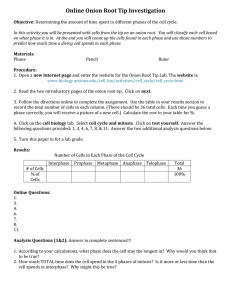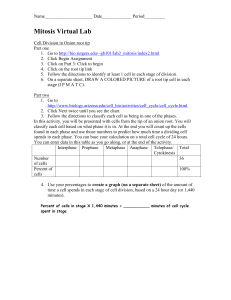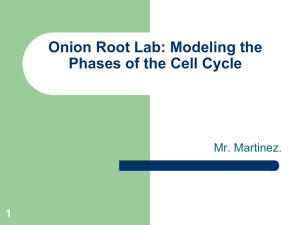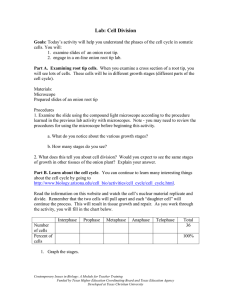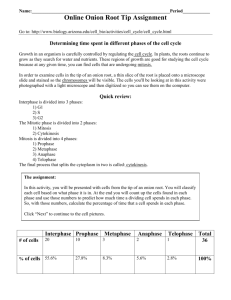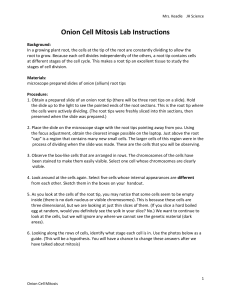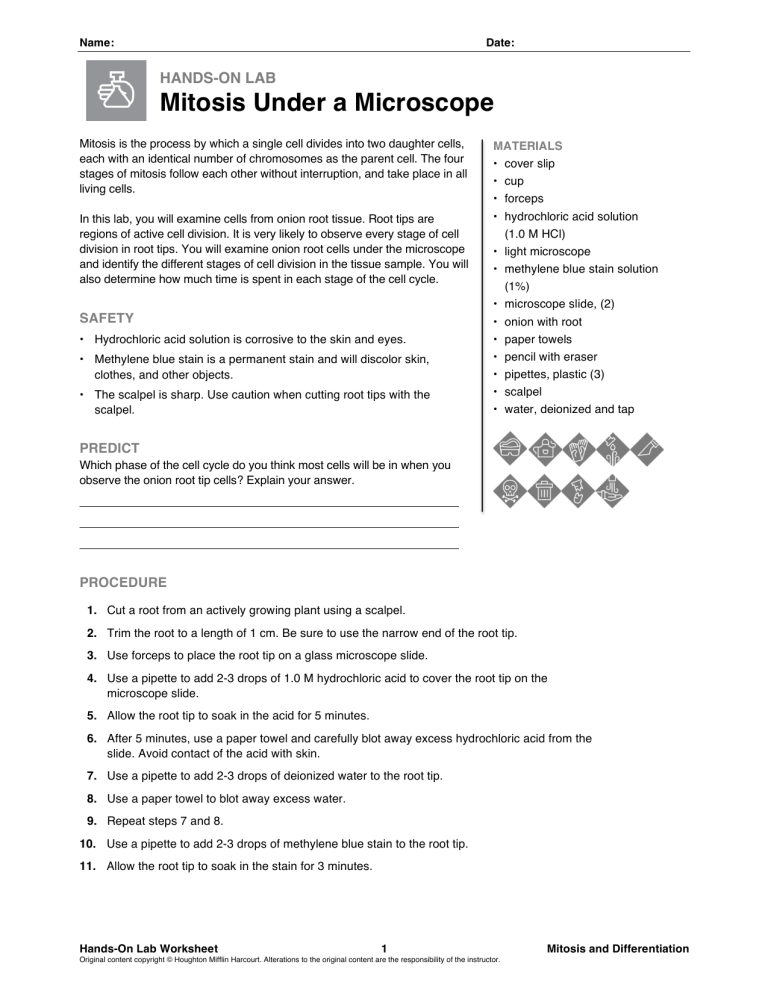
Name: Date: HANDS-ON LAB Mitosis Under a Microscope Mitosis is the process by which a single cell divides into two daughter cells, each with an identical number of chromosomes as the parent cell. The four stages of mitosis follow each other without interruption, and take place in all living cells. MATERIALS In this lab, you will examine cells from onion root tissue. Root tips are regions of active cell division. It is very likely to observe every stage of cell division in root tips. You will examine onion root cells under the microscope and identify the different stages of cell division in the tissue sample. You will also determine how much time is spent in each stage of the cell cycle. • hydrochloric acid solution (1.0 M HCl) • light microscope SAFETY • onion with root • paper towels • pencil with eraser • Hydrochloric acid solution is corrosive to the skin and eyes. • Methylene blue stain is a permanent stain and will discolor skin, clothes, and other objects. • The scalpel is sharp. Use caution when cutting root tips with the scalpel. • cover slip • cup • forceps • methylene blue stain solution (1%) • microscope slide, (2) • pipettes, plastic (3) • scalpel • water, deionized and tap PREDICT Which phase of the cell cycle do you think most cells will be in when you observe the onion root tip cells? Explain your answer. PROCEDURE 1. Cut a root from an actively growing plant using a scalpel. 2. Trim the root to a length of 1 cm. Be sure to use the narrow end of the root tip. 3. Use forceps to place the root tip on a glass microscope slide. 4. Use a pipette to add 2-3 drops of 1.0 M hydrochloric acid to cover the root tip on the microscope slide. 5. Allow the root tip to soak in the acid for 5 minutes. 6. After 5 minutes, use a paper towel and carefully blot away excess hydrochloric acid from the slide. Avoid contact of the acid with skin. 7. Use a pipette to add 2-3 drops of deionized water to the root tip. 8. Use a paper towel to blot away excess water. 9. Repeat steps 7 and 8. 10. Use a pipette to add 2-3 drops of methylene blue stain to the root tip. 11. Allow the root tip to soak in the stain for 3 minutes. Hands-On Lab Worksheet 1 Original content copyright © Houghton Mifflin Harcourt. Alterations to the original content are the responsibility of the instructor. Mitosis and Differentiation Name: Date: 12. Use a paper towel to blot away excess methylene blue stain. 13. Add 1 drop of deionized water to the root tip. 14. Use forceps to move the root tip to a clean microscope slide. 15. Place a cover slip on the root tissue. Using the eraser end of a pencil, gently apply pressure on the cover slip to squash the root tissue. Apply an even, downward pressure on the cover slip. Be careful not to twist the coverslip or push down so hard that it breaks. 16. Starting with low magnification on a light microscope, view the root tip cells. Adjust the power as necessary. 17. Find examples of cells in each stage of the cell cycle. In Data Table 1, draw the cell and label the structures within each cell. DATA TABLE 1: STAGES OF THE CELL CYCLE INTERPHASE PROPHASE METAPHASE ANAPHASE TELOPHASE 18. Select a random area of the slide to study using the high-power lens. 19. Record the number of cells in each stage of the cell cycle in Data Table 2. 20. Repeat steps 18 and 19 two more times. DATA TABLE 2: STAGES OF THE CELL CYCLE SAMPLE TOTAL CELLS # INTERPHASE # % PROPHASE # % METAPHASE # % ANAPHASE # % TELOPHASE # % 1 2 3 Hands-On Lab Worksheet 2 Original content copyright © Houghton Mifflin Harcourt. Alterations to the original content are the responsibility of the instructor. Mitosis and Differentiation Name: Date: ANALYZE AND CONCLUDE 1. Calculate the percentage of cells in each part of the cell cycle for each sample, and record it in Data Table 2. Show your calculations in the space below. Sample Calculation: # of cells in interphase Í 100 Í % of cells in interphase total number of cells ___________________________________________________________________________ ___________________________________________________________________________ ___________________________________________________________________________ ___________________________________________________________________________ ___________________________________________________________________________ ___________________________________________________________________________ 2. What patterns do you see in your data? In which stage of the cell cycle are most of the cells you examined? How do these data support what you know about the cell cycle? ___________________________________________________________________________ ___________________________________________________________________________ ___________________________________________________________________________ ___________________________________________________________________________ ___________________________________________________________________________ ___________________________________________________________________________ ___________________________________________________________________________ ___________________________________________________________________________ 3. Find the average percentage of cells in each stage of the cell cycle among the three samples. Assume that a cell takes 24 hours to complete one cell cycle. Calculate how much time is spent in each stage of the cell cycle. Show your calculations in the space below. (Hint: Multiply the percentage of cells in each stage, as a decimal, by 24 hours.) ___________________________________________________________________________ ___________________________________________________________________________ ___________________________________________________________________________ ___________________________________________________________________________ ___________________________________________________________________________ 4. The cells in the root of an onion are actively dividing. How might the numbers you count here be different than if you had examined cells from a different part of the plant? Explain your answer. ___________________________________________________________________________ ___________________________________________________________________________ ___________________________________________________________________________ ___________________________________________________________________________ ___________________________________________________________________________ Hands-On Lab Worksheet 3 Original content copyright © Houghton Mifflin Harcourt. Alterations to the original content are the responsibility of the instructor. Mitosis and Differentiation Name: Date: 5. A chemical company is testing a new product that it thinks will increase the growth rate of food plants. Suppose you are able to view the slides of onion root tips that have been treated with the product. If the product is successful, how might the slides look different from the slides you viewed in this lab? Draw what the treated slides might look like. EXTEND Design an experiment that would test the product described in Question 5. Assume the product is a liquid that can be added to the soil in which the plant is growing. Provide an outline of your procedure. Hands-On Lab Worksheet 4 Original content copyright © Houghton Mifflin Harcourt. Alterations to the original content are the responsibility of the instructor. Mitosis and Differentiation
